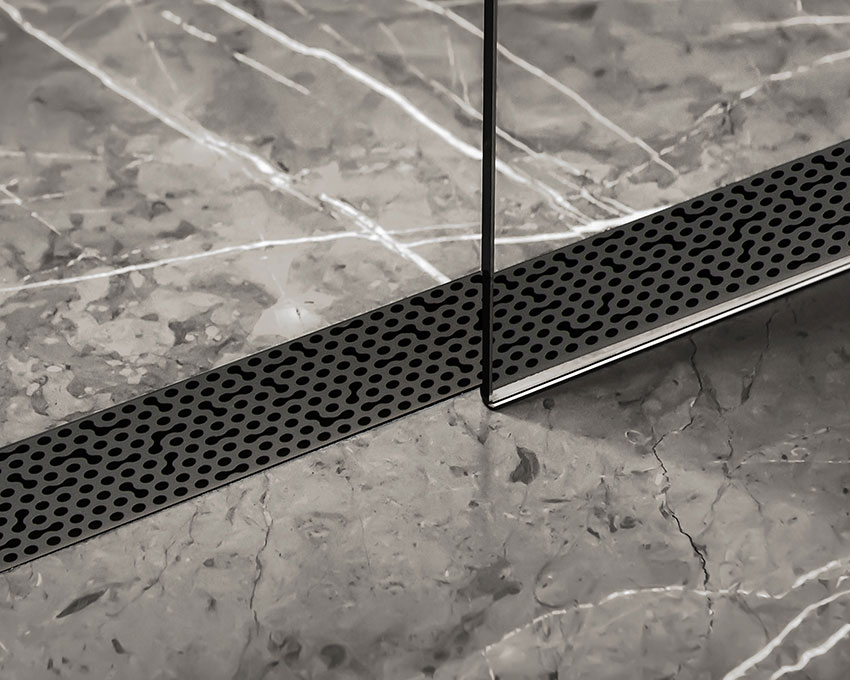Understanding Architectural Linear Drains
Design Trends
Designers should be aware of current trends to respond to requests from clients, building owners, and users. Here are some current trends that relate to spaces where architectural linear drains are commonly used.
- Elevated Design: Bathrooms, in particular, have become spaces where functionality meets quiet luxury. Emphasizing the fusion of utility and elegance, quiet luxury requires high-quality details that have a timeless appeal. Linear drains, with the possibility of inserting tiles to match the surrounding floor, exemplify this trend by simply blending into their surroundings and disappearing from view. This subtlety allows designers to craft thoughtful spaces that transform into personal oases. Quiet luxury also relies on continuity of visual elements, such as wall-to-wall linear drains or those that are flush against floors. Typically, linear drains are located on one end of a space and are not recommended for the center of a shower or similar area. Center drains designed specifically for that purpose are better suited there.
- Customization of Finishes: The visible part of the drainage system is the exposed grate or covering. To elevate the design of the spaces where the drains are located, manufacturers are offering a full range of standard finishes and the ability to meet current needs with custom options. Current trends for hardware and fixtures tend to feature softened metallics like brushed or champagne gold, which introduce warmth and help ground modern environments. Similarly, pastel colors continue to make headway by evoking nostalgia and serve as an antidote to anxiety and fast-paced lifestyles. Manufacturers offer many personalized options, including custom finishes, which allow consumers, designers, and architects the flexibility to make creative, stunning choices. At least one manufacturer has even worked directly with architectural firm Gensler to have them design new products for general use as well as their own projects.
- Accessible Showers: Many people prefer the ability to walk in or roll in (if needed) to a shower without a curb or other encumbrance. This is evident in many hospitality locations as well as residences of all types. Size-adjustable architectural linear drain products have been providing this capability for quite some time. This choice offers an elegant aesthetic and enhances safety and accessibility for all. As more owners and users request this capability, the use of these kinds of linear drains will likely continue to grow.
For an overall insight on the design aspects of these products, Jonathan Brill, founder and CEO of Infinity Drain, says, “Normally people think of architectural drainage as something utilitarian, something you have to have, and it gets put in without much thought. We often get the comment, ‘Wow, I never really thought of the drain before… until we saw one that was beautiful.’ That’s what makes architectural drains that unique, yet vital detail that elevates the spaces they are specified for.”

Photo courtesy of Infinity Drain
The finish and appearance of architectural linear drains can be selected and matched to current design trends in different building conditions.

Photo courtesy of Infinity Drain
The visible grates of architectural linear drains are available in a variety of patterns and colors, plus some that are designed to “disappear” into the surrounding floor surface by using tile inserts along a wall edge.
PERFORMANCE CONSIDERATIONS
The performance of any type of drain product will depend both on the drain construction and its manner of operation. These attributes are both part of the system that isn’t typically seen but is critical to perform properly.
All drains have a capacity of how much water can be drained over a given amount of time (i.e., gallons per minute). The drain piping is usually sized by a consulting engineer to match the needs of the area being drained based on a calculated volume and rate of water being managed. In the same way, any drainage system, particularly the channel, must be assessed for the capacity of the water it can receive and drain over time. If the channel is too large compared to the piping, there is a risk of water pooling at the drain since water is captured faster than it can be drained away. If the channel is too small, water may pool outside of the drain because the system cannot adequately capture all the water present. For linear drains, the size of the drain is not just the length, but also the depth of the channel which can vary. Therefore, for the best drainage performance, water flow calculations need to be considered for anything that is not a small or typical drainage condition such as a bathroom shower. Outdoor drainage designs, in particular, should be addressed in this way since an abundance of rainwater can overwhelm any drainage solution.
Keeping the above in mind, we can turn our attention to some of the particular details of architectural linear drains.
Channel Assembly/Catchment
This component is the working part of the drain that is concealed below the grate and fabricated to first catch then direct the water to the drainpipe. It is the part that needs to be designed into the floor or surface so that it provides the needed solution and is integrated as a flush, finished condition. Commonly, the channel assembly is made from stainless steel, but some PVC channels are also available. There are several general types from which to select.
- Site-Sizable Installations consist of modular linear drain components that can be cut to fit on site or joined together to span any length. The outlet for this type can be located anywhere along the channel run. It is available in kit lengths or as a set of components in both stainless steel and PVC. Site-sizable installations can use traditional waterproofing methods.
- Fixed-Length Installations are prefabricated to specific lengths to be installed directly into the on-site construction. They include pre-pitched channels with a set outlet location. Both standard kit sizes and custom fabrication are available. Made from stainless steel, they are also intended to be installed with traditional waterproofing methods.
- Fixed-Flange Installations are used when a vertical outlet is used for direct connection to the drain piping. They include a pre-pitched flanged channel with set outlet location. Standard kit sizes or custom fabrication are available, all made from stainless steel. This type should only be installed with liquid membrane or fabric sheet waterproofing methods.
- Side Outlet Installations are used where a vertical outlet is not practical. They include a pre-pitched flanged channel with a set outlet location and horizontal (side) outlet. Standard kit sizes or custom fabrication are available in stainless steel. As with fixed flange installations, side outlet channels should only be installed with liquid membrane or fabric sheet waterproofing methods.
The height of channel assemblies ranges from 1” to 1-5/8.” The lower profile 1” channel height makes barrier-free installation easier in some cases. Such reduced height channels are likely to be reinforced on the sides with extra grooves or flanges to provide increased stability in mortar-set installations.
Grate Styles
Typically, the grates or covers are fabricated out of metal, most often from different types of stainless steel. The thickness of the steel can vary from 18 gauge down to 7 gauge to suit different project weight-bearing conditions. The final appearance can vary based on the selection of the pattern of openings (linear grate, holes, etc.) and the final color of the finished metal. In this way, the drain grate can either blend into the floor surface to be less noticeable or be used to create a contrasting line that works toward a purpose in the overall design.
If the desire is to have the cover blend into the surrounding surface and visually disappear, there are options to have a linear opening on either side of a central section that is designed to receive finishing material or tile that matches the surroundings. Hence, the linear drain takes on the same appearance as the surrounding floor or outdoor surface. If complete obscurity is sought, there is also the option of using a recessed reveal slot drain such that the flooring extends over the flange of the channel and allows the water to enter into the channel via a 3/8-inch reveal in the surface of the floor. A small, removable panel allows the channel and drain line to be accessed in this case. Because of these different approaches, it is easy to see why linear architectural drains offer an elegant and coordinated look for architects and designers to create well-designed, elegant spaces without the visual interruption of the grates or covers. Most of the covers are standardized by manufacturers and have likely already been tested for safety, but if there is any concern, a review of any safety testing should be done.
Waterproofing
Depending on the application, there may be a need to provide a waterproofing material or membrane around the drain channel, just as with any surface that is exposed to water. This is important to keep the water where it needs to be and not seeping elsewhere, both for safety and hygiene. The type of waterproofing can vary depending on the type of drain and compatibility with the material of the channel assembly. The key is to integrate drain components with a waterproofing membrane in a way that is also compatible with the surrounding floor construction.

Images courtesy of Infinity Drain
Waterproofing membranes that are pre-applied to architectural drains are available such that they can provide added protection against water leakage.









